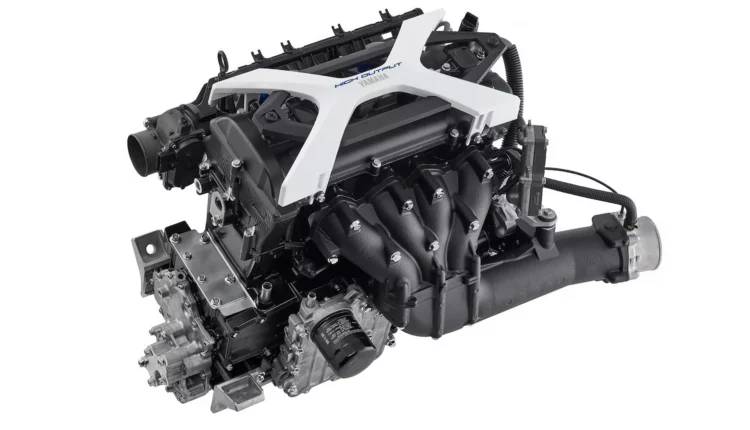©2021 Reporters Post24. All Rights Reserved.
It seems like electric motors are coming for damn near every segment now, including watercraft. Take the recent acquisition of German electric boat motor manufacturer, Torqeedo, by Yamaha for instance, as that is arguably one of the most blatant tell-tale signs that the end is nigh for all forms of the internal combustion engine. Or is it?
Earlier this year, Yamaha Motor unveiled an outboard engine prototype at the 2024 Miami International Boat Show that was powered purely by hydrogen. This hydrogen-powered outboard engine prototype is based on Yamaha’s flagship 5.6L V8 model, which makes a hefty 450 horsepower. But what about those of us who aren’t into massive V8 outboard engines, or don’t want to wait around to see if a prototype ever comes to life?
Well, Yamaha has an answer for that as well, with an all-new, 1.9-liter four-cylinder marine engine. Making 200 horsepower at 7,600 rpm in naturally aspirated form, this rev-happy four-banger marks the first full redesign of Yamaha’s high-output (HO) engine in over 15 years. This bump in displacement makes this HO variant the highest output naturally aspirated water-jet propulsion engine on the market today. Oh, and apparently it’s partially made from plant resins to keep all the hippies happy.
What Makes the All-New 1.9L HO Yamaha Marine Engine So Kickass?
As we have discussed in previous boat-oriented engine articles, full-on throttle for prolonged periods necessitates the need for insanely strong internals. A Honda S2000 engine might rev to 9,000 rpm, but keeping it in that range for over an hour is just a recipe for disaster.
Boat engines operate very differently, and most of the time are either at idle or gunning for full open throttle. Furthermore, boat motors of this caliber benefit from the environment they skim across. The jet drive on these engines plays double-duty as a water pump and can therefore be classified as a closed-loop cooling system. This increases cooling and longevity and eliminates the need for a complex (and costly) cooling system like what is found in automobiles.
“The more powerful engine provides quicker and smoother acceleration and a higher top speed. This is achieved through the engine’s increased displacement, optimized intake, and exhaust paths, and a 10-percent larger throttle body for more power and torque.”
While the new 1.9L HO motor is based upon its predecessor’s architecture, this newer version has seen some significant enhancements, including:
- Increased bore size, to 88 mm (from 86 mm)
- New exhaust manifold piping emphasizing flow on cylinders one and four
- New intake manifold design with longer runners and a flat shape for easy engine removal
- Cooling channel for funneling H20 between exhaust valve seats
- 0.5-quart reduction in oil required, thus negating windage losses and increasing power across the board
- Charging system reliability improvements, including the sourcing of cooling water for the regulator/rectifier from the cylinder head rather than the exhaust manifold
- Taper-free throttle body for better throttle response and the relocation of vital electronics inboard for better protection during service procedures
- Relocated oil fill and thermostat
- Easy-access crankcase anode
- New crankcase assembly design for better cam gear access and better oil flow throughout the engine
- Black anodized engine cover and exhaust manifold
- CNF engine shrouding
Naturally, a supercharger upgrade for this new 1.9-liter Yamaha watercraft motor is inevitable. In the interim, there are other options available. Unlike automobiles, you can always double down and outfit your boat with a twin-engine configuration for a full 400 horsepower in naturally aspirated form. Photo Credit: Yamaha
Resin: It’s Not Just From Burning Bong Loads Anymore
Now, about that resinous armor wrapping around this rev-happy boat engine…
Yamaha has been tinkering with Cellulose Nanofiber (CNF) compositions for a few years now and has finally gotten to the point where it is ready to release this reinforced resin. Used solely on the exterior of these engines (for now) this high-strength material offers the ultimate balance between flexibility, rigidity, and hippie-friendly formulation. According to the manufacturer, the entire product manufacturing process is based upon “kneading and dispersing CNF, a biomass material made from wood resources, into resins such as polypropylene.”
Weighing significantly less than existing resin materials, this CNF stuff has excellent material recyclability, thus cutting down on the amount of plastics used and greenhouse gas emissions like CO₂. Furthermore, this is the world’s first case of mass-producing parts for vehicles using this material, and we get the feeling that it’s just a matter of time until our car bumpers and boat hulls are built from this plant-based material.





